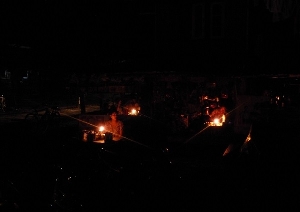 Mr. Yirenkyi, Senior Revenue Officer in Charge of Customs Laboratory, Customs Division of the GRA
Mr. Yirenkyi, Senior Revenue Officer in Charge of Customs Laboratory, Customs Division of the GRA
A Senior Revenue Officer in Charge of Customs Laboratory, Customs Division of the Ghana Revenue Authority, Richard Adu Yirenkyi, has expressed the need for a review of some customs policies that would bring about a needed improvement in the handling of dangerous and hazardous cargo.
“Obviously we need to review some of our policies. We have learnt a lot and it is possible our policy and programmes department would review some of our policies,” he said.
The Senior Revenue Officer came to the admission that a consideration to change some laws that govern the handling of hazardous cargo may improve the role Customs play in the handling of such cargo in Ghana’s port environment.
Speaking on Eye on Port on Lessons Learnt from the Lebanon Port Explosion, the Customs Official confirmed that the country’s ports take delivery of nine different categories of hazardous cargo where Customs Authorities follow the laid down customs steps of handling all cargo, which includes seizure, detention and confiscation after twenty-one (21) days of non-clearance by consignee.
“When there is a breach in customs procedure, we first detain the consignment for 30 days pending production of necessary document, from the regulators, and after 30 days, if the importer fails to appear, then it moves to seizure, which is also another 30 days,” he explained.
He said although in rare instances, aside the non-payment of duties, sometimes improper labelling, wrong declaration among many other infringements may also cause the detention of dangerous cargo.
“We do not detain much of those dangerous goods at the ports, unless maybe the importer of the declarant fails to declare to customs. When you fail to declare to customs, it is a customs offense and we treat it as such.”
The Customs officer revealed that, after confiscation of uncleared hazardous cargo, such goods are kept in storage at the designated Tema Bonded Terminal where such cargos are kept.
“In the case of dangerous goods, you can’t directly move them to the State Warehouse due to the hazardous nature so we have what we call constructive warehousing at TBT,” he explained.
He educated that, even though revenue mobilization and trade facilitation are among their key objectives as a state institution, the security of the country’s people and environment are paramount.
Hence, the need to ensure that the paperwork supporting such dangerous cargo are accurate before releasing them to individuals or companies who have imported them into the country.
“As dangerous as they are, they need to be controlled so we don’t just allow them onto the market, without the necessary procedures,” he stated.
Mr. Yirenkyi encouraged importers to ensure to acquire all necessary permits as well as accurately declare such dangerous cargo in order to help authorities conduct speedy checks on them for easy release.
He revealed that although customs work 24 hours of everyday of the week at the MPS Terminal 3 for containerized cargo, they do not work at other terminals like the Tema Bonded Terminal, the dedicated terminal for the storage of hazardous cargo, on Sundays.
The Customs officer opined that a 24/7 port at all terminals would expedite movement of cargoes particularly those with hazardous and dangerous content in and out of the port.
“So far, it is proven that working 24/7 is very successful at MPS, so it is very possible if same treatment can be extended to such items.”
The incident at Beirut Port in Lebanon, on the 4th of August is believed to have begun from an initial fire around a Warehouse in the port, which ignited about 2,750 tonnes of ammonium nitrate in the warehouse causing a colossal explosion that travelled as far as 5 miles away from the port.
Many properties in the city were destroyed and over 300,000 people misplaced and 5,000 injured with about 200 people confirmed dead.












